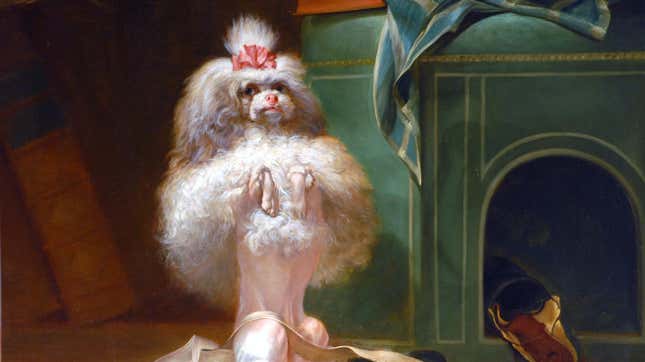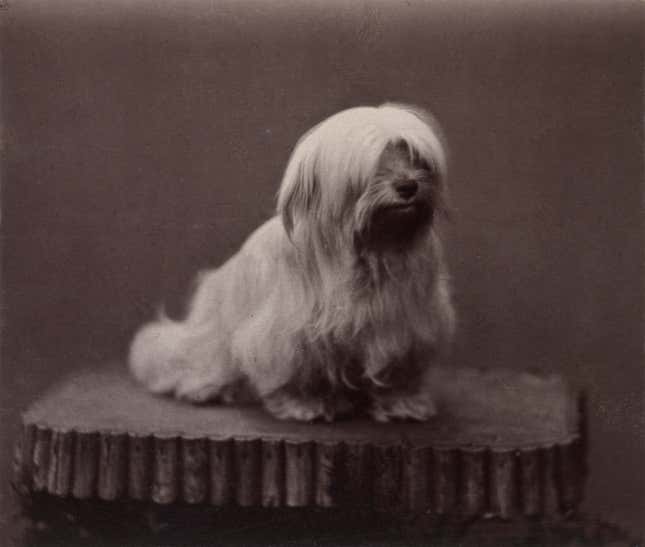A Kooky Exhibit Helped Me Process How Much I Miss My Ex’s Dog
An exhibition featuring art and oddities about dogs helped me process how much I miss my ex's beagle.
In DepthIn Depth

In my favorite photo of Charley, she is gazing into the distance, eyes full of awe, alone among the candy-colored banners of a deserted Times Square. It was taken in the summer of 2020, when the busiest streets of New York were eerily empty. You might think that Charley had survived the apocalypse, and that she was ready—her ears pushed confidently back—to take on whatever challenges come with being the last beagle on earth. She seems to be looking just over the viewer’s shoulder; the photographer—my ex-boyfriend—must have crouched down on the sidewalk to capture her at eye-level. I liked the photo so much that I got it printed out and framed.
In my least favorite photo of Charley—taken a year and a half later, before I left our apartment for the last time—her eyes are downcast; her tail is drooping. Half of her body is obscured by shadow. Her ears are pushed forward over her face, like a nervous middle-schooler trying to hide behind her hair. The fur around the edges of her ears has faded from chestnut to white. She looks betrayed. She looks reproachful. She looks depressed.
Or maybe she was hungry. Am I projecting my own feelings onto an animal whose look of longing might just as easily have been about the chicken bone that got away? How much do we impose our complicated human emotions onto images of dogs?
I thought about these questions at the Wallace Collection’s new exhibit “Portraits of Dogs: From Gainsborough to Hockney” in London (where I now live), as I took in paintings of a poodle dressed up as a judge and of a toy Havanese, a pink ribbon in its fur and a guilty expression on its face, perched “as though seeking forgiveness” (according to the wall text) beside a chewed-up shoe.
On the surface, the show—which features such curiosities as a ruby-encrusted Faberge replica (on loan from His Majesty) of a favorite royal dog; a semi-erotic 1st-century statue of a greyhound nibbling her mate’s ear; and a Leonardo da Vinci study of a paw—is intended as a charming diversion, a celebration of humans’ special bond with our canine companions. The Evening Standard described it as “very jolly,” though a cranky Guardian reviewer (clearly a cat person) complained that the collection was pandering to dog parents. “To love this exhibition,” he wrote “you need to…own a dog.”
I disagree. I—only a former dog step-parent—loved it. And not, as the Guardian suggested, for the dumb pleasure of seeing a 19th century terrier dressed up in a Scottish bonnet.
It was when I reached the room on grief that I knew I would stay until the museum closed. It helped me grapple with a question I’d been struggling with for months: Was I crazy to mourn a dog that was still alive? A dog that—judging by my ex’s Strava locations—had, until recently, been living just a few miles away?

“Portraits of Dogs” attests to the poignant, creative and sometimes disturbing ways that we have grieved dogs, from taxidermy to modern art. I saw the stuffed remains of a Maltese terrier named Minna which have, since 1883, been resting in an elaborate cabinet, alongside etchings of castles and flowers. I read Lord Byron’s lyrical epitaph to his beloved Newfoundland, Boatswain. Days later, I am still haunted by Lucian Freud’s painting of his late whippet’s gravestone—the dog’s name (Pluto) inscribed in childlike block letters that look, somehow, both freshly-carved and already-fading. I saw intricate Victorian brooches adorned with portraits of dogs’ faces and holding locks of their hair.
I understand the impulse to preserve a dog’s fur. When I lived with Charley, her constant shedding was a source of irritation. Her hairs were prone to clogging the vacuum cleaner and lodging themselves in the stitches of my sweaters (where they would inevitably pass undetected until some crucial moment). When I finally brought myself to unpack the suitcase I’d grabbed on my way out, a flurry of Charley hairs flew out. I gathered up my clothes and stuffed them back in my bag.
-

-

-

-

-

-

-

-

-

-

-

-

-

-

-

-

-

-

-

-

-

-

-

-

-

-

-

-

-

-

-

-

-

-

-

-

-

-

-

-








































